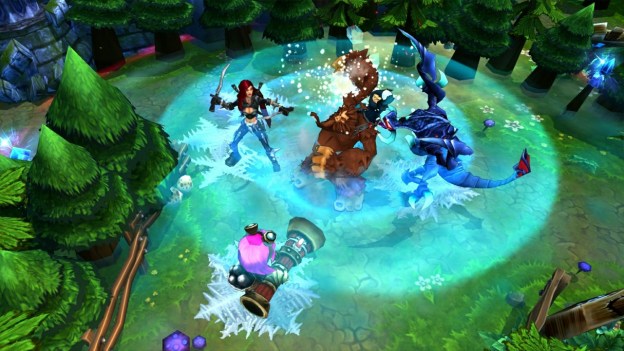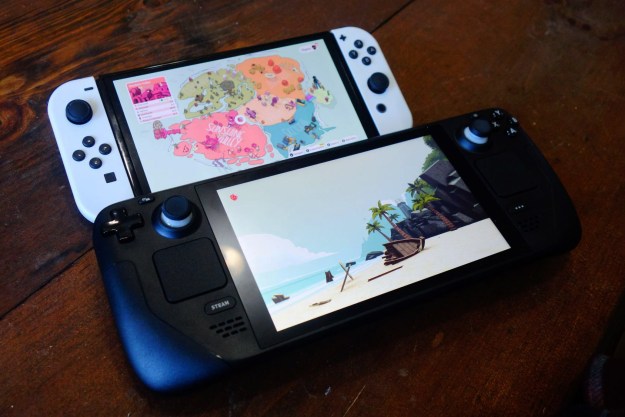
The online games space is rapidly evolving. There’s a reason that Blizzard Entertainment recently opened up its World of Warcraft (WoW) massively multiplayer online (MMO) game world for free to anyone who wants to play up to Level 20. The reigning champion of subscription games is feeling the repercussions of a growing wave of free-to-play games from companies like Riot Games, GamersFirst and Turbine.
New research from social gaming service Xfire shows that World of Warcraft has officially been dethroned as the number one game on its popular game-tracking service, which tracks gaming hours spent by its over 19 million players. The new most-played title is Los Angeles-based Riot Game’s League of Legends. While WoW continues to attract over 11 million subscription gamers worldwide, the game giant lost approximately 600,000 players during its last quarter. And the explosion of free-to-play offerings, including many new games unveiled at E3, could further erode those loyal players.
World of Warcraft held Xfire’s coveted top spot from 2005 to June 17, 2011. Although there was a brief increase in WoW players at the end of 2010 and beginning of 2011, this was largely due to the Cataclysm expansion pack release, as the surge quickly declined thereafter. This decline showed that WoW gamers were quickly finishing the game, but not returning to re-play it. In September 2009, there were 60,000 daily active unique (DAU) WoW players on Xfire; today that number is approximately 30,000 DAU players – a 50 percent decline, while League of Legends grew to more than 34,000 DAU Xfire players because of several key factors, including its free-to-play business model. World of Warcraft costs $20 to purchase, in addition to paid expansion packs and a $15 monthly subscription fee.

“Our 19 million users have avidly played World of Warcraft for the past seven years; we knew it would eventually be overtaken but what really surprised us was the rapid ascension of League of Legends and free-to-play games in general,” said Xfire President, Mark Donovan. “The free-to-play model is becoming much more prolific in the gaming industry, and one major trend we’re seeing is that there are a vast number of games initially developed as subscription titles that failed to gain critical mass, then re-launched with a free-to-play model with great success. Results from many free-to-play games, including GamersFirst’s All Points Bulletin: Reloaded and Turbine’s Lord of the Rings Online have been extremely positive.”
Donovan believes the recent move by Blizzard to open up the world of Azeroth for free shows that they understand the magnitude of the shift that’s quickly reshaping the online games space.
“It’s just much easier for competitors of free-to-play games to provide really good experiences,” said Donovan. “Blizzard has recognized that they need to provide an extended free-to-play service in order to give users a much longer trial period so that they can up-sell them later.”

The Lego Group has also taken this approach with its Lego Universe MMO game. After selling only 65,000 copies of its $50 PC game in the U.S., according to The NPD Group, the toy maker is discontinuing retail sales of the game in August and making it available as a free digital download. Players can access two adventure zones and one player property area for free for as long as they want. Those who want the full experience can purchase a subscription package.
E3 saw the resurrection of many games that were long considered dead, but have been reborn with the free-to-play model. All Points Bulletin: Reloaded shot to number six on Xfire after its free-to-play beta re-launch, which also showed a 200 percent increase over its most-played day as a paid title. Not even the marketing power of Electronic Arts could generate interest in Realtime Worlds’ MMO as a paid game. The game developer went bankrupt, but gamers are flocking to the new free version.
Turbine, the publisher of Lord of the Rings Online, recently announced that the game quadrupled its active user-base and tripled revenue when it switched to the free-to-play model. Other early success stories have prompted many games to announce shifts to the free-to-play model, including Cross Fire, Fallen Earth, Age of Conan, City of Heroes, and Hellgate London.

“The most interesting thing to look at after a game changes to the free-to-play model is that a title like APB’s usage on Xfire was two times what it was at its peak as a paid game,” said Donovan. “Lord of the Rings shot from number 20 to number 8 on Xfire in November with the free-to-play model and Turbine quadrupled their user base and tripled their revenues, as well.”
There is no better example of the successful free-to-play model than in Asia, specifically Korea, Southeast Asia and China. In the Korean market, which many consider to be the PC gaming capital of the world, there are hardly any publishers left that charge up-front fees for online games, and the primary revenue model is micro-transactions. Freemium and micro-transaction models have also become standard in the social gaming space. Companies like Zynga are generating massive revenues by giving their games away for free and monetizing small amounts of their player base.
Nexon, which offers all of its games for free, has over 1 billion accounts worldwide with hit games like Maple Story, Dungeon Fighter Online, Dragon Nest, and Vindictus. Min Kim, vice president of marketing at Nexon America, believes this is just the beginning.

“The North American market is really starting to take off and we see 2015 as being our banner year,” said Kim. “That’s the year when like all these Club Penguin kids start growing up, and they already will have these social experiences, and they’re probably going to want that from their games. We think that these next few years are going to be banner years for us and other companies that are as successful in adopting this model.”
Donovan believes this freemium revenue model will own the lion’s share of the overall gaming market in the long run. Disney Online has been active in this space with huge Hollywood franchises like World of Cars Online, Pirates of the Caribbean Online, and Disney Faeries Pixie Hollow.
Sony Online Entertainment has seen its family-friendly Free Realms game attract over 17 million subscribers on both the PC and PlayStation 3. The company’s president, John Smedley, believes Free Realms could top 100 million subscribers in the next six years.
“As traditional console game sales stagnate, even incumbents like Activision and Electronic Arts are paying attention and are being pressured to develop their own free-to-play titles,” added Donovan.
All of this is good news for gamers, because many of the new titles getting a second life online didn’t fail because of a lack of gameplay. The subscription model has traditionally handicapped good games because consumers lacked the funds to invest in multiple titles. With no cost of entry, more players can try more titles.


